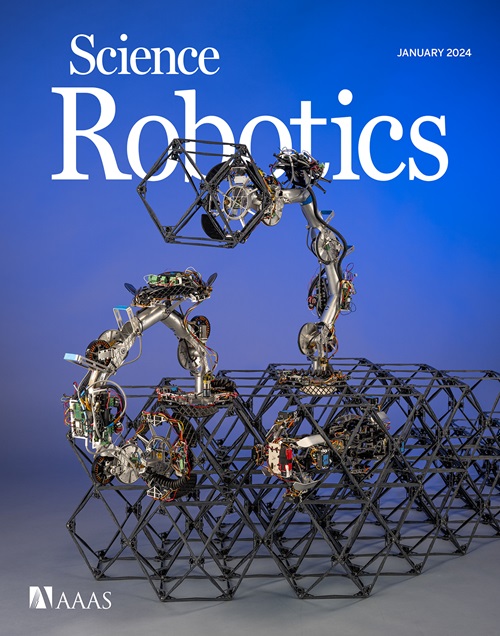Photocatalytic microrobots for treating bacterial infections deep within sinuses
IF 27.5
1区 计算机科学
Q1 ROBOTICS
引用次数: 0
Abstract
Microrobotic techniques are promising for treating biofilm infections located deep within the human body. However, the presence of highly viscous pus presents a formidable biological barrier, severely restricting targeted and minimally invasive treatments. In addition, conventional antibacterial agents exhibit limited payload integration with microrobotic systems, further compromising therapeutic efficiency. In this study, we propose a photocatalytic microrobot through a magnetically guided, optical fiber–assisted therapeutic platform specifically designed to treat bacterial infections in deep mucosal cavities. The microrobots comprising copper (Cu) single atom–doped bismuth oxoiodide (BiOI), termed CBMRs, can be guided and tracked by real-time x-ray imaging. Under external magnetic actuation, the illuminated region from the magnetically guided optical fiber synchronously follows the CBMR swarm, enabling effective antibacterial action at targeted infection sites. Upon continuous visible-light irradiation, the resultant photothermal effect substantially reduces the viscosity of pus on inflamed mucosal tissues, enhancing the penetration capability of the CBMR swarm by more than threefold compared with baseline conditions. Concurrently, atomic-level design of CBMRs facilitates robust generation of reactive oxygen species, enabling efficient biofilm disruption and reductions in bacterial viability. We validated the effectiveness of this integrated optical fiber–assisted microrobotic platform in a rabbit sinusitis model in vivo, demonstrating its potential for clinically relevant infection therapy.
用于治疗鼻窦深处细菌感染的光催化微型机器人
微型机器人技术有望用于治疗人体深处的生物膜感染。然而,高粘性脓液的存在是一个强大的生物屏障,严重限制了靶向和微创治疗。此外,传统抗菌剂与微型机器人系统的有效载荷集成有限,进一步降低了治疗效率。在这项研究中,我们提出了一种光催化微型机器人,通过磁引导,光纤辅助治疗平台,专门设计用于治疗深部粘膜腔细菌感染。这种由铜(Cu)单原子掺杂氧化碘化铋(BiOI)组成的微型机器人被称为CBMRs,可以通过实时x射线成像进行引导和跟踪。在外部磁驱动下,来自磁导光纤的照明区域同步跟随CBMR群,从而在目标感染部位实现有效的抗菌作用。在持续的可见光照射下,所产生的光热效应大大降低了发炎粘膜组织上脓液的粘度,与基线条件相比,CBMR群的穿透能力提高了三倍以上。同时,CBMRs的原子水平设计有助于活性氧的生成,从而有效地破坏生物膜并降低细菌的生存能力。我们在兔鼻窦炎模型中验证了这种集成光纤辅助微型机器人平台的有效性,证明了其在临床相关感染治疗中的潜力。
本文章由计算机程序翻译,如有差异,请以英文原文为准。
求助全文
约1分钟内获得全文
求助全文
来源期刊

Science Robotics
Mathematics-Control and Optimization
CiteScore
30.60
自引率
2.80%
发文量
83
期刊介绍:
Science Robotics publishes original, peer-reviewed, science- or engineering-based research articles that advance the field of robotics. The journal also features editor-commissioned Reviews. An international team of academic editors holds Science Robotics articles to the same high-quality standard that is the hallmark of the Science family of journals.
Sub-topics include: actuators, advanced materials, artificial Intelligence, autonomous vehicles, bio-inspired design, exoskeletons, fabrication, field robotics, human-robot interaction, humanoids, industrial robotics, kinematics, machine learning, material science, medical technology, motion planning and control, micro- and nano-robotics, multi-robot control, sensors, service robotics, social and ethical issues, soft robotics, and space, planetary and undersea exploration.
 求助内容:
求助内容: 应助结果提醒方式:
应助结果提醒方式:


